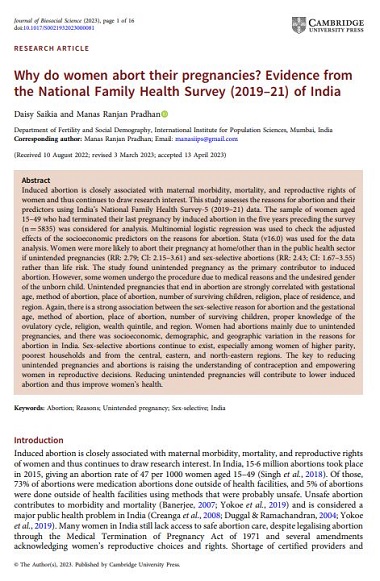
Induced abortion is closely associated with maternal morbidity, mortality, and reproductive rights of women and thus continues to draw research interest. This study assesses the reasons for abortion and their predictors using India’s National Family Health Survey-5 (2019–21) data. The sample of women aged 15–49 who had terminated their last pregnancy by induced abortion in the five years preceding the survey (n=5835) was considered for analysis. Multinomial logistic regression was used to check the adjusted effects of the socioeconomic predictors on the reasons for abortion. Stata (v16.0) was used for the data analysis. Women were more likely to abort their pregnancy at home/other than in the public health sector if unintended pregnancies (RR: 2.79; CI: 2.15–3.61) and sex-selective abortions (RR: 2.43; CI: 1.67–3.55) rather than life risk. The study found unintended pregnancy as the primary contributor to induced abortion. However, some women undergo the procedure due to medical reasons and the undesired gender of the unborn child. Unintended pregnancies that end in abortion are strongly correlated with gestational age, method of abortion, place of abortion, number of surviving children, religion, place of residence, and region. Again, there is a strong association between the sex-selective reason for abortion and the gestational age, method of abortion, place of abortion, number of surviving children, proper knowledge of the ovulatory cycle, religion, wealth quintile, and region. Women had abortions mainly due to unintended pregnancies, and there was socioeconomic, demographic, and geographic variation in the reasons for abortion in India. Sex-selective abortions continue to exist, especially among women of higher parity, poorest households and from the central, eastern, and north-eastern regions. The key to reducing unintended pregnancies and abortions is raising the understanding of contraception and empowering women in reproductive decisions. Reducing unintended pregnancies will contribute to lower induced abortion and thus improve women’s health.
Saikia, D., & Pradhan, M. (2023). Why do women abort their pregnancies? Evidence from the National Family Health Survey (2019–21) of India. Journal of Biosocial Science, 1-16.